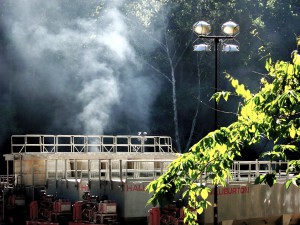Exposed: Fracking
The last decade has seen a rapid expansion of the drilling method known as hydraulic fracturing, or fracking. Sand and chemicals — including known carcinogens — are mixed with water and injected deep underground to extract natural gas from shale rock formations. Yet many chemicals remain unknown because companies may claim them as trade secrets.
Hydraulic fracturing in Appalachia currently occurs in Ohio and West Virginia, while the more shallow rock formations in Tennessee, southwest Virginia and Kentucky require an alternative process called nitrogen fracking, which replaces much of the water in fracking fluid with nitrogen gas.
As much as 90 percent of fracking fluids remain underground, and whatever does return brings with it new contaminants such as salts, radioactive material and heavy metals. This waste is stored in open-air pits before shipment to treatment plants, but dangerous levels of contaminants remain even after treatment and, in some cases, reaction with disinfectants may form additional toxic byproducts.

At this natural gas drilling site, one of more than 100 owned by EQT in northern West Virginia, diesel emissions from heavy drilling equipment pollute the air. Photo courtesy of Wetzel County Action Group
Exemption from hazardous waste regulations allows the solid, treated waste to be dumped into the same type of landfill as household trash. Most of the liquid treated waste is discharged into streams and lakes, and the remainder is injected into disposal wells, where it can seep into groundwater and has triggered earthquakes.
Both wells and waste-containment ponds can release chemicals into air and water through evaporation and leaks. In Pennsylvania, state officials this summer confirmed 243 known cases of private drinking water well contamination by the natural gas industry since drilling expanded in 2008.
Groundwater and air contaminants confirmed by government and university-led studies include hydrogen sulfide, which can affect brain and respiratory health, and methane, an explosion hazard and contributor to climate change. Carcinogens in the mix include arsenic, benzene and formaldehyde. As benzene and formaldehyde evaporate and join exhaust fumes from transportation vehicles at the drilling site, they form ground-level ozone, which causes respiratory diseases.
Related Articles
Latest News

Leave a comment
Your email address will not be published. Required fields are marked *





Leave a Comment